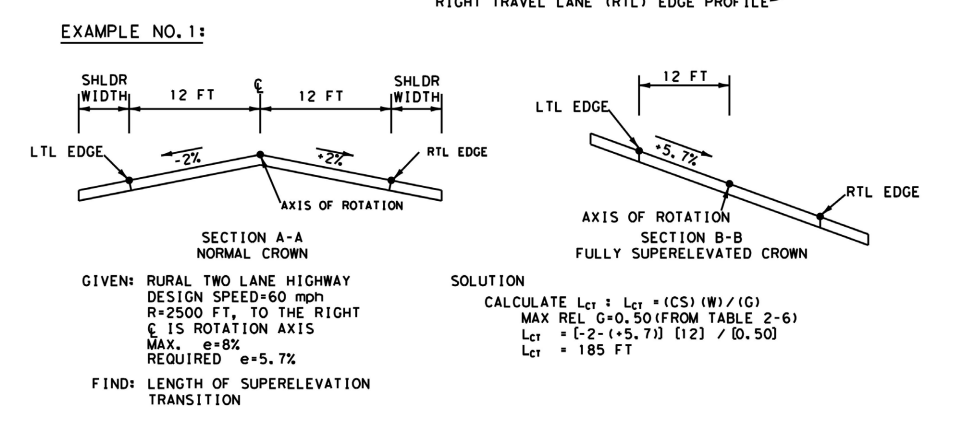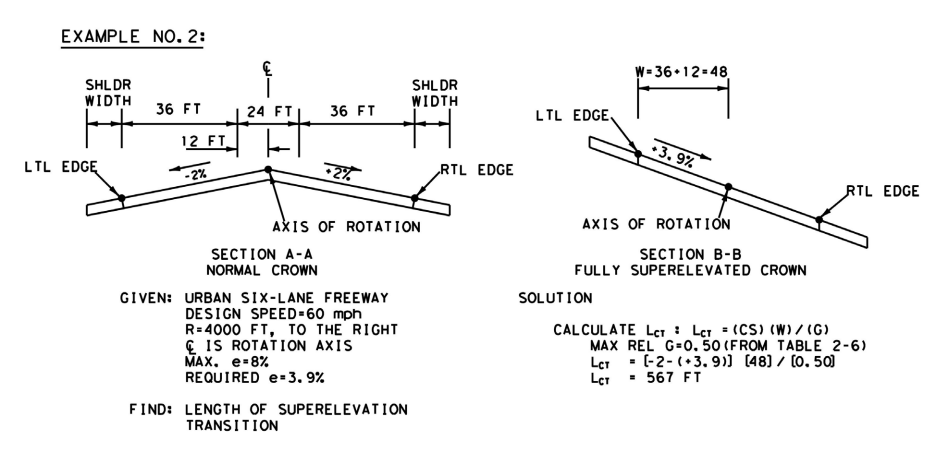4.7.6 Superelevation Transition Length
Superelevation transition is the general term denoting the change in cross slope from a normal crown section to the full superelevated section or vice versa. To meet the requirements of comfort and safety, the superelevation transition should occur over a length adequate for the usual travel speeds.
Transition lengths should also account for potential future traveled way widening, including widening associated with the ultimate typical section in a schematic.
Preferable design values for length of superelevation transition are based on a given maximum relative gradient between profiles of the edge of traveled way and the axis of rotation.
shows recommended maximum relative gradient values. Transition length on this basis is directly proportional to the total superelevation, which is the product of the lane width and the change in cross slope.
Design Speed (mph) | Maximum Relative Gradient 1 (%) | Equivalent Maximum Relative Slope (run:rise) |
15 | 0.89 | 1:112 |
20 | 0.80 | 1:125 |
25 | 0.73 | 1:137 |
30 | 0.67 | 1:150 |
35 | 0.62 | 1:162 |
40 | 0.57 | 1:175 |
45 | 0.53 | 1:187 |
≥50 | 0.50 | 1:200 |
Notes: | ||
| ||
Preferable transition length, L
CT
, can be calculated using the following equation:Where:
L
Calculated preferable transition length, ft CT (preferable)
= CS =
Change in cross slope of superelevated pavement, percent W =
distance between the axis of rotation and the edge of traveled way, ft G =
maximum relative gradient (%).Example determinations of superelevation transition are shown in
.



Figure 4-2: Determination of Length of Superelevation Transition
As the number of lanes to be transitioned increases, the length of superelevation transition increases proportionately with the increased width. While strict adherence to the length (L
CT
) calculation is preferable, the length for multilane facilities may become impractical for design purposes (e.g., drainage problems, avoiding bridges, accommodating merge/diverge condition).A minimum length (L
CT
), can be calculated using adjustment factors as shown in
, such that the transition length formula becomes:where “b” is defined in Table 4-9.
In the case of one lane being rotated, “b” is 1.0, such that L
CT (min)
= LCT (preferable)
Number of Lanes Rotated (n) | Adjustment Factor 2 (b) |
1.5 | 0.83 |
2 | 0.75 |
2.5 | 0.70 |
3 | 0.67 |
3.5 | 0.64 |
4 | 0.63 |
4.5 | 0.61 |
5 | 0.60 |
Notes: | |
| |